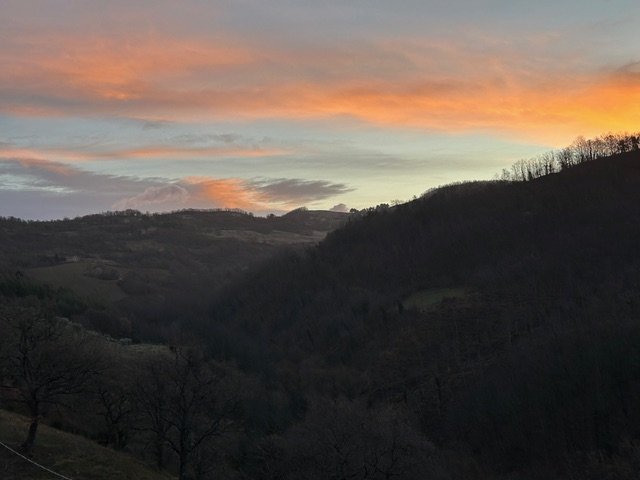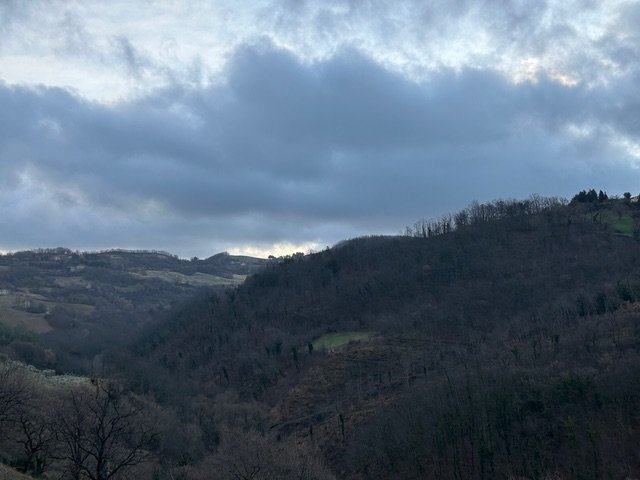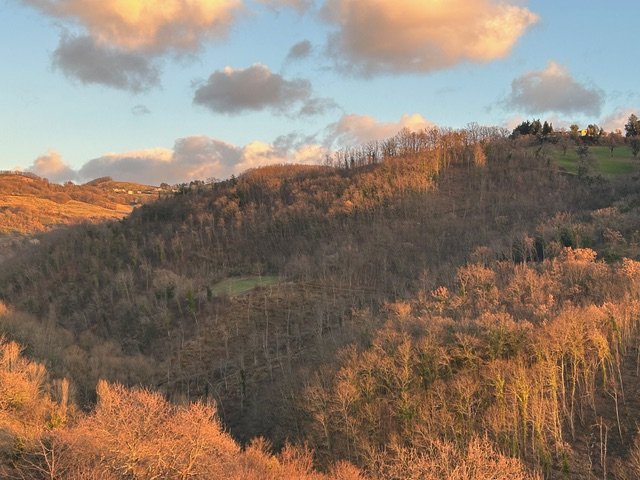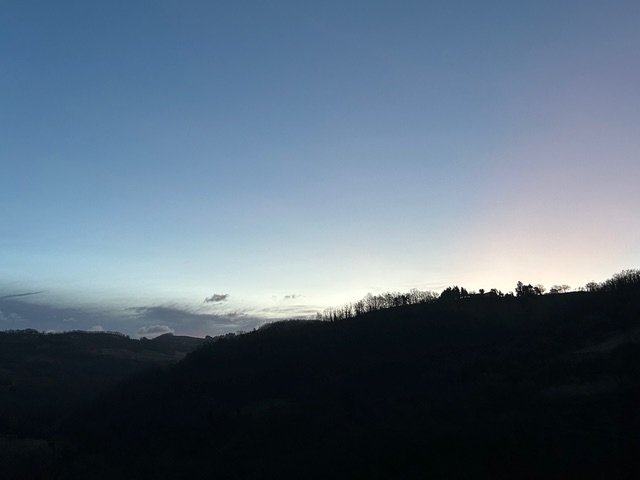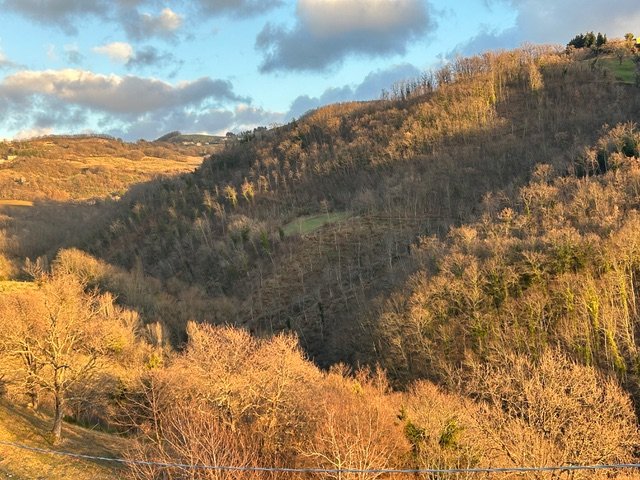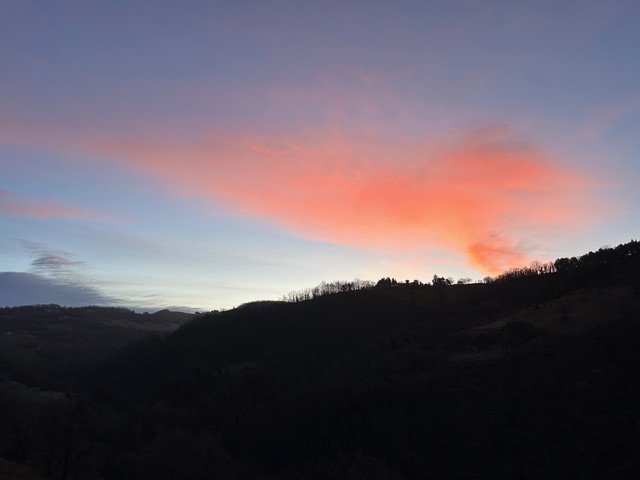Deep Winter Beauty
When people complain about how grey, how bleak, how cold our winter is, I know they cannot be farmers or country folk. This is our holiday time. Our vacation. A time of replenishing our energy. A time of renewal.
We are eating our summer and fall harvests, getting fat, and sleeping. Our animal companions too. Some time before the first day of winter, long after our big olive harvest, I brought in the last of the summer and fall vegetables, leaving all the winter crops to fend for themselves. I was more than ready to relinquish the last of autumn's warmth. Now, in January and February, I have the luxury of time, lots of time. It’s a well kept farmer's secret that we are all on vacation, though I hear of the non-stop toil of the farmer. But when one is working with the natural rhythms of the plants and the animals, and not imposing industrial standards on the natural world, our work is minimal.
At 5 PM it is dark. We close up the barns and revel in the brilliant red sunsets of winter. I am so ready to retreat to the back of the cave, make a fire, and crawl deep into a waiting book. In February, the cupboard is still packed with canned and dried food. There are more than enough cold weather crucifers and salads in the garden. The fava bean plants promise to flower soon but the artichokes aren't sure, saying they may wait another month. Their reluctance to get growing tells me that it's not yet time to make plans for spring planting. Way too early. We let the animals out of the barns in the morning and make sure they have grain and fresh water. We clean up the stalls—more compost for the soil. I like the physicality. It is the only farm-related exercise I get these days. Housekeeping for the animals takes a half hour at the start and end of the day. After rooting about for worms, the ducks look for a sunny spot in the barnyard, tuck their heads under their wings, and sleep. The chickens bunch together, also in the sun, and dust bathe. The donkeys find a grazing area and are content to stay put. There are no crops to tend. The rest of the day is mine.
No one is out planting. Many of the farmers are in town. Taking a coffee and cornetto. Some are at the outdoor tables ringing the old castle, enjoying the sun. Many meet up at the small weekly outdoor market among the stalls of vegetables. No one is in a hurry. Only the tourists would be energetically walking the local hiking trails just outside town. A group of men are sitting outside the gas station, a favorite meeting spot. They talk on old metal chairs, kept there just for them. I run into friends and neighbors. I gossip with one for over thirty minutes; the longest he has ever spoken to me. We have the time. Not one word about the weather, not a word about the porcupines stealing his potato crop or the fox making off with his chickens. What a joy to not be fretting about the rain, either too much or not enough, or whether there will be an olive or walnut or whatever harvest this year. When we say goodbye there are hugs and kisses on both cheeks. And no one is sweaty.
When the artichokes are sending up their flower stalks and the chicories begin to fill out, I will be ready to seed. (The presence or absence of certain plants, when they begin to leaf out, the height of the river, the birds gathering straw for nests, the fox hunting past the early morning light, all tell me when I need to gear up.) I will know when to go back to my full-time internship with Mother Nature. Until then, my main job, when I am not sleeping, is chronicler of wonder. Deep winter is exquisitely beautiful with its own unique seasonal high points, whether it is a blizzard, a frozen fairyland, or slender branches dancing wildly in the wind. When we first became farmers, it took us ages to pull it together and get up with the rooster. Now, though sunrise is not until seven, we are wide awake in winter's six o'clock darkness. The stars are still out. And the moon. Unable to sleep any longer, Phil takes the dogs out for a long run on the road while I languish in bed. Then he puts the kettle on. (For this, he is my hero.) But I am up, always before our sunrise, which is always spectacular. Spring through fall I sit outside with my wake-up cup of tea – but in winter, full of the deep sleep one has after a cold night under mountains of blankets, I am still dreamy and quite content to watch the beauty unfold from the window. I spend a half hour with our mountainside as she slowly comes alive.
Our nights hover at zero centigrade, a cold winter for central Umbria. And for this I am grateful. I tend to fret about the trees a great deal, worrying that if winters warm, the oaks and cedars and pines, all the perennials, will be stressed, will not have a cold dormancy. This year, I welcomed the cold, the wind chill, the damp more than ever before. Much of life in these parts is in hibernation now, not just the bears. The drop in temperature, the shorter days, the sun rising lower in the sky triggers us all to slow growth, some of us lose our leaves, and we metaphorically crawl deep into the back of the cave. The major stimulus to plants is the decreasing light. With less sunlight, photosynthesis slows, the sugars made in the process translocate downward to be stored in the roots. And with cold temperature, there is a metabolic work stoppage which stimulates the loss of leaves in deciduous plants. By shedding its leaves, the plant conserves water. Even the evergreens lose some leaves. The more light energy is converted to chemical energy, the more water and constant nutrition is needed. It is so much easier to do less, to simply slow down all processes, to avoid being at risk. But growth continues. In the winter, the tree roots continue to grow. They have monopolized all the energy and moisture, all the activity. The below ground parts are not hibernating with the rest of us. And the stored carbs protect the roots of all the perennial plants against freezing.
Winter is a season of great beauty in its own right. On the land, up close and personal, everything is vibrantly alive and interconnected. There are buds on all the trees, on all the perennial shrubs. Just waiting. Along the ground, the chickweed and the margueritas (winter blooming flowers) are lush. The old trees are full of vitality, covered in moss and lichen and ivy. The bare branches elegant against a clear blue sky. And though I can't see it, the soil community is still vital and hard at work, still exchanging minerals for carbs, still absorbing and distributing water, multiplying bacteria and fungal hyphae. The goddess is in the details.
This is the time of the year when we can see the true grandness of our trees. Without their leaves, each grandmother oak stands out as an individual. Huge. Powerful. It is as if the entire tree was inverted, its leafy branches plunged into the earth and its entire root system framed against the sky. The smaller juvenile oaks just fade into the forest from spring through fall but in the winter light, holding onto their brown leaves, they are positively golden. The last hour of available sunlight is always the most spectacular time of the day, the young oaks in their glory, gilding the entire mountainside.
I am not ignoring nor accepting climate change, but because we continue to degrade our only support system with alarming speed does not stop my revelling in her incredible beauty and power, no matter how violent or erratic. I am horrified when trees are cut but I also see the saplings emerge between the stumps and where—in total defiance of the chainsaw—the tree sprouts again from the cut. These days I know little about the joys of city life, but I know the power and beauty of the natural world which, no matter how wounded, still thrills me, still gives me solace and even peace.
Deep winter has given me enough time to take a long pause to appreciate what I have. At this moment. Whatever I have right in front of me. By the time dormancy is broken, when there is bud break, when the sun is higher in the sky, the day lengthening and the soil warming (when the hormones, sugars, and minerals move up from the roots into the above-ground parts) I will be so very ready to get my hands in the soil. But until then I am on vacation.
In a previous lifetime, Zia Gallina worked as a botanist for the U.S. National Parks Service, lecturing on indigenous and naturalized medicinal and culinary plants. She was also an adjunct professor of biology and environmental science at American University, Washington D.C. But she has always been, first and foremost, a farmer and a champion of small-scale biointensive farming, tagging behind Mother Nature, trying to stay as close as she can get. She lives in the mountains of Umbria.
